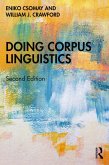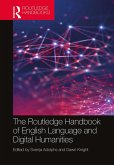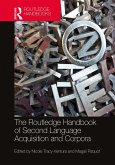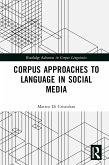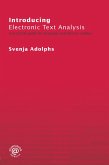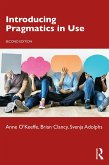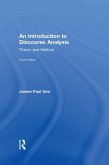41,95 €
41,95 €
inkl. MwSt.
Sofort per Download lieferbar

21 °P sammeln
41,95 €
Als Download kaufen

41,95 €
inkl. MwSt.
Sofort per Download lieferbar

21 °P sammeln
Jetzt verschenken
Alle Infos zum eBook verschenken
41,95 €
inkl. MwSt.
Sofort per Download lieferbar
Alle Infos zum eBook verschenken

21 °P sammeln
- Format: ePub
- Merkliste
- Auf die Merkliste
- Bewerten Bewerten
- Teilen
- Produkt teilen
- Produkterinnerung
- Produkterinnerung

Bitte loggen Sie sich zunächst in Ihr Kundenkonto ein oder registrieren Sie sich bei
bücher.de, um das eBook-Abo tolino select nutzen zu können.
Hier können Sie sich einloggen
Hier können Sie sich einloggen
Sie sind bereits eingeloggt. Klicken Sie auf 2. tolino select Abo, um fortzufahren.

Bitte loggen Sie sich zunächst in Ihr Kundenkonto ein oder registrieren Sie sich bei bücher.de, um das eBook-Abo tolino select nutzen zu können.
Doing Corpus Linguistics offers a practical step-by-step introduction to corpus linguistics, making use of widely available corpora and a register analysis-based theoretical framework to provide applied linguistics and TESOL students with the understanding and skills to analyze corpora and carry out successful corpus-based research.
- Geräte: eReader
- mit Kopierschutz
- eBook Hilfe
Andere Kunden interessierten sich auch für
![Doing Corpus Linguistics (eBook, PDF) Doing Corpus Linguistics (eBook, PDF)]() Eniko CsomayDoing Corpus Linguistics (eBook, PDF)41,95 €
Eniko CsomayDoing Corpus Linguistics (eBook, PDF)41,95 €![The Routledge Handbook of English Language and Digital Humanities (eBook, ePUB) The Routledge Handbook of English Language and Digital Humanities (eBook, ePUB)]() The Routledge Handbook of English Language and Digital Humanities (eBook, ePUB)49,95 €
The Routledge Handbook of English Language and Digital Humanities (eBook, ePUB)49,95 €![The Routledge Handbook of Second Language Acquisition and Corpora (eBook, ePUB) The Routledge Handbook of Second Language Acquisition and Corpora (eBook, ePUB)]() The Routledge Handbook of Second Language Acquisition and Corpora (eBook, ePUB)46,95 €
The Routledge Handbook of Second Language Acquisition and Corpora (eBook, ePUB)46,95 €![Corpus Approaches to Language in Social Media (eBook, ePUB) Corpus Approaches to Language in Social Media (eBook, ePUB)]() Matteo Di CristofaroCorpus Approaches to Language in Social Media (eBook, ePUB)42,95 €
Matteo Di CristofaroCorpus Approaches to Language in Social Media (eBook, ePUB)42,95 €![Introducing Electronic Text Analysis (eBook, ePUB) Introducing Electronic Text Analysis (eBook, ePUB)]() Svenja AdolphsIntroducing Electronic Text Analysis (eBook, ePUB)41,95 €
Svenja AdolphsIntroducing Electronic Text Analysis (eBook, ePUB)41,95 €![Introducing Pragmatics in Use (eBook, ePUB) Introducing Pragmatics in Use (eBook, ePUB)]() Anne O'KeeffeIntroducing Pragmatics in Use (eBook, ePUB)31,95 €
Anne O'KeeffeIntroducing Pragmatics in Use (eBook, ePUB)31,95 €![An Introduction to Discourse Analysis (eBook, ePUB) An Introduction to Discourse Analysis (eBook, ePUB)]() James Paul GeeAn Introduction to Discourse Analysis (eBook, ePUB)47,95 €
James Paul GeeAn Introduction to Discourse Analysis (eBook, ePUB)47,95 €-
-
-
Doing Corpus Linguistics offers a practical step-by-step introduction to corpus linguistics, making use of widely available corpora and a register analysis-based theoretical framework to provide applied linguistics and TESOL students with the understanding and skills to analyze corpora and carry out successful corpus-based research.
Dieser Download kann aus rechtlichen Gründen nur mit Rechnungsadresse in A, B, BG, CY, CZ, D, DK, EW, E, FIN, F, GR, HR, H, IRL, I, LT, L, LR, M, NL, PL, P, R, S, SLO, SK ausgeliefert werden.
Produktdetails
- Produktdetails
- Verlag: Taylor & Francis eBooks
- Seitenzahl: 184
- Erscheinungstermin: 28. Februar 2024
- Englisch
- ISBN-13: 9781003836513
- Artikelnr.: 69854407
- Verlag: Taylor & Francis eBooks
- Seitenzahl: 184
- Erscheinungstermin: 28. Februar 2024
- Englisch
- ISBN-13: 9781003836513
- Artikelnr.: 69854407
- Herstellerkennzeichnung Die Herstellerinformationen sind derzeit nicht verfügbar.
Eniko Csomay is a Professor in the Department of Linguistics and Asian/Middle Eastern Languages at San Diego State University, USA.
William J. Crawford is a Professor in the Department of English at Northern Arizona University, USA.
William J. Crawford is a Professor in the Department of English at Northern Arizona University, USA.
List of Tables
List of Figures
Preface
Acknowledgments
PART I
Introduction to Doing Corpus Linguistics and Register Analysis
1 Linguistics, Corpus Linguistics, and Language Variation
1.1 Language and Rules/Systems
1.2 What Is Corpus Linguistics?
1.3 Register, Genre, and Style - Is There a Difference?
1.4 Outline of the Book
2 Register (Functional) Approach to Language Analysis
2.1 Why Register?
2.2 What Is a Register (Functional) Analysis?
2.3 Describing Situational Characteristics and Identifying Variables
2.4 Providing a Functional Interpretation
2.5 Units of Analysis and Register Studies
2.6 End of Chapter Exercises
PART II
Searches in Available Corpora
3 Searching a Corpus
3.1 Words
3.2 Collocates
3.3 N-Grams
3.4 POS Tags
4 Projects Using Publicly Available Corpora
4.1 Word- and Phrase-Based Projects
4.2 Grammar-Based Projects
PART III
Building Your Own Corpus, Analyzing Your Quantitative Results, and Making Sense of Data
5 Building Your Own Corpus
5.1 Do-It-Yourself Corpora
5.2 Deciding on a Corpus Project
5.3 Building a Corpus
5.4 Software Programs and Your Corpus
6 Basic Statistics
6.1 Why Do Statistical Analyses?
6.2 Basic Terms, Concepts, and Assumptions
6.3 How to Go About Getting the Statistical Results
6.4 End of Chapter Exercises
7 Statistical Tests (ANOVAs, Chi-square, Pearson Correlation)
7.1 Difference Tests
7.2 Relationship Tests
7.3 How to Go About Getting the Statistical Results
7.4 Effect Size
7.5 End of Chapter Exercises
8 Doing Corpus Linguistics
8.1 Doing a Register Analysis of Your Project
8.2 Situational Analysis
8.3 Linguistic Analysis
8.4 Functional Interpretation
8.5 Reporting on Your Project
9 A Way Forward
Available Corpora
Index
List of Figures
Preface
Acknowledgments
PART I
Introduction to Doing Corpus Linguistics and Register Analysis
1 Linguistics, Corpus Linguistics, and Language Variation
1.1 Language and Rules/Systems
1.2 What Is Corpus Linguistics?
1.3 Register, Genre, and Style - Is There a Difference?
1.4 Outline of the Book
2 Register (Functional) Approach to Language Analysis
2.1 Why Register?
2.2 What Is a Register (Functional) Analysis?
2.3 Describing Situational Characteristics and Identifying Variables
2.4 Providing a Functional Interpretation
2.5 Units of Analysis and Register Studies
2.6 End of Chapter Exercises
PART II
Searches in Available Corpora
3 Searching a Corpus
3.1 Words
3.2 Collocates
3.3 N-Grams
3.4 POS Tags
4 Projects Using Publicly Available Corpora
4.1 Word- and Phrase-Based Projects
4.2 Grammar-Based Projects
PART III
Building Your Own Corpus, Analyzing Your Quantitative Results, and Making Sense of Data
5 Building Your Own Corpus
5.1 Do-It-Yourself Corpora
5.2 Deciding on a Corpus Project
5.3 Building a Corpus
5.4 Software Programs and Your Corpus
6 Basic Statistics
6.1 Why Do Statistical Analyses?
6.2 Basic Terms, Concepts, and Assumptions
6.3 How to Go About Getting the Statistical Results
6.4 End of Chapter Exercises
7 Statistical Tests (ANOVAs, Chi-square, Pearson Correlation)
7.1 Difference Tests
7.2 Relationship Tests
7.3 How to Go About Getting the Statistical Results
7.4 Effect Size
7.5 End of Chapter Exercises
8 Doing Corpus Linguistics
8.1 Doing a Register Analysis of Your Project
8.2 Situational Analysis
8.3 Linguistic Analysis
8.4 Functional Interpretation
8.5 Reporting on Your Project
9 A Way Forward
Available Corpora
Index
List of Tables
List of Figures
Preface
Acknowledgments
PART I
Introduction to Doing Corpus Linguistics and Register Analysis
1 Linguistics, Corpus Linguistics, and Language Variation
1.1 Language and Rules/Systems
1.2 What Is Corpus Linguistics?
1.3 Register, Genre, and Style - Is There a Difference?
1.4 Outline of the Book
2 Register (Functional) Approach to Language Analysis
2.1 Why Register?
2.2 What Is a Register (Functional) Analysis?
2.3 Describing Situational Characteristics and Identifying Variables
2.4 Providing a Functional Interpretation
2.5 Units of Analysis and Register Studies
2.6 End of Chapter Exercises
PART II
Searches in Available Corpora
3 Searching a Corpus
3.1 Words
3.2 Collocates
3.3 N-Grams
3.4 POS Tags
4 Projects Using Publicly Available Corpora
4.1 Word- and Phrase-Based Projects
4.2 Grammar-Based Projects
PART III
Building Your Own Corpus, Analyzing Your Quantitative Results, and Making Sense of Data
5 Building Your Own Corpus
5.1 Do-It-Yourself Corpora
5.2 Deciding on a Corpus Project
5.3 Building a Corpus
5.4 Software Programs and Your Corpus
6 Basic Statistics
6.1 Why Do Statistical Analyses?
6.2 Basic Terms, Concepts, and Assumptions
6.3 How to Go About Getting the Statistical Results
6.4 End of Chapter Exercises
7 Statistical Tests (ANOVAs, Chi-square, Pearson Correlation)
7.1 Difference Tests
7.2 Relationship Tests
7.3 How to Go About Getting the Statistical Results
7.4 Effect Size
7.5 End of Chapter Exercises
8 Doing Corpus Linguistics
8.1 Doing a Register Analysis of Your Project
8.2 Situational Analysis
8.3 Linguistic Analysis
8.4 Functional Interpretation
8.5 Reporting on Your Project
9 A Way Forward
Available Corpora
Index
List of Figures
Preface
Acknowledgments
PART I
Introduction to Doing Corpus Linguistics and Register Analysis
1 Linguistics, Corpus Linguistics, and Language Variation
1.1 Language and Rules/Systems
1.2 What Is Corpus Linguistics?
1.3 Register, Genre, and Style - Is There a Difference?
1.4 Outline of the Book
2 Register (Functional) Approach to Language Analysis
2.1 Why Register?
2.2 What Is a Register (Functional) Analysis?
2.3 Describing Situational Characteristics and Identifying Variables
2.4 Providing a Functional Interpretation
2.5 Units of Analysis and Register Studies
2.6 End of Chapter Exercises
PART II
Searches in Available Corpora
3 Searching a Corpus
3.1 Words
3.2 Collocates
3.3 N-Grams
3.4 POS Tags
4 Projects Using Publicly Available Corpora
4.1 Word- and Phrase-Based Projects
4.2 Grammar-Based Projects
PART III
Building Your Own Corpus, Analyzing Your Quantitative Results, and Making Sense of Data
5 Building Your Own Corpus
5.1 Do-It-Yourself Corpora
5.2 Deciding on a Corpus Project
5.3 Building a Corpus
5.4 Software Programs and Your Corpus
6 Basic Statistics
6.1 Why Do Statistical Analyses?
6.2 Basic Terms, Concepts, and Assumptions
6.3 How to Go About Getting the Statistical Results
6.4 End of Chapter Exercises
7 Statistical Tests (ANOVAs, Chi-square, Pearson Correlation)
7.1 Difference Tests
7.2 Relationship Tests
7.3 How to Go About Getting the Statistical Results
7.4 Effect Size
7.5 End of Chapter Exercises
8 Doing Corpus Linguistics
8.1 Doing a Register Analysis of Your Project
8.2 Situational Analysis
8.3 Linguistic Analysis
8.4 Functional Interpretation
8.5 Reporting on Your Project
9 A Way Forward
Available Corpora
Index

